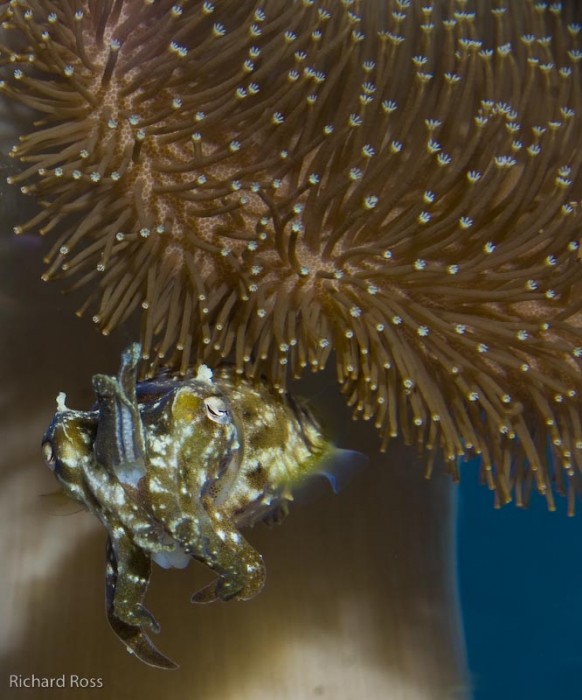
The California Academy of Sciences’ Steinhart Aquarium recently became the first aquarium in the U.S. to successfully breed Sepia bandensis, more commonly known as dwarf cuttlefish. Pioneered by Academy marine biologist and Reef Builders’ own Rich Ross, the breeding program has reared over 350 dwarf cuttlefish with most being distributed to other aquariums and research institutions. Despite the name, dwarf cuttlefish are not “fish†but members of the class Cephalopoda, which also includes octopus, squid, and the chambered nautilus.
“By establishing a stable breeding population,” Ross, who has been working with cuttlefish since 2002 and put this project in motion last spring, explains, “our hope is to make it easier for aquariums to showcase cuttlefish and their remarkable characteristics without impacting wild populations.”  In a 120-gallon aquarium at the aquarium, anchored to an algae-covered a cluster of inky-colored eggs is beginning to swell and will soon become hatchlings. The parents of this batch consist of two males and four females. Eggs were collected with Ross hatching and raising them. Males and females are shuffled in as they became sexually mature to increase the chances of mating and spawning. Hundreds of tiny-hatchlings, exact replicas of their adult counterparts, get hand fed at least twice a day by Ross and his team. As with most new breeding programs, the feeding strategy is the key to survival and growth to adulthood and this was no different. Without other successful programs and literature to guide him, Ross was on his own. He soon discovered young cuttlefish require live meals beginning with mysis shrimp, increasing in size with age. Hunting with a pair of feeding tentacles, dwarf cuttlefish can devour prey the length of their own bodies.
In a 120-gallon aquarium at the aquarium, anchored to an algae-covered a cluster of inky-colored eggs is beginning to swell and will soon become hatchlings. The parents of this batch consist of two males and four females. Eggs were collected with Ross hatching and raising them. Males and females are shuffled in as they became sexually mature to increase the chances of mating and spawning. Hundreds of tiny-hatchlings, exact replicas of their adult counterparts, get hand fed at least twice a day by Ross and his team. As with most new breeding programs, the feeding strategy is the key to survival and growth to adulthood and this was no different. Without other successful programs and literature to guide him, Ross was on his own. He soon discovered young cuttlefish require live meals beginning with mysis shrimp, increasing in size with age. Hunting with a pair of feeding tentacles, dwarf cuttlefish can devour prey the length of their own bodies.
“Consistent feeding is important. They have been getting live cragnon shrimp twice a day as adults, and live mysis as hatchlings,” said Ross. “Getting a group to successfully live together has also been important, and consists mostly of separating fighting males before they do damage to each other, and feeding them enough so they don’t start to eat each other.”
 Typically cuttlefish range in size from 15 to 25 cm with the largest of the species reaching up to 50cm in length, the adult dwarf cuttlefish, native to the Indo-Pacific region, range from 5-10 cm requiring less resources to keep as its larger relatives. Being the first of its kind providing a sustainable captive source, the Academy hopes other zoos and aquariums will take advantage of the opportunity to share these intriguing animals with their visitors.
Typically cuttlefish range in size from 15 to 25 cm with the largest of the species reaching up to 50cm in length, the adult dwarf cuttlefish, native to the Indo-Pacific region, range from 5-10 cm requiring less resources to keep as its larger relatives. Being the first of its kind providing a sustainable captive source, the Academy hopes other zoos and aquariums will take advantage of the opportunity to share these intriguing animals with their visitors.
Known for their highly developed brains, nervous systems, and eyes, cephalopods’ advanced capabilities pose a host of unanswered questions about the nature of intelligence in invertebrates and vertebrates. Sepia bandensis frequently flash moving patterns across its skin, and can quickly blend into its surroundings and beneath that ever-changing exterior it’s physiology is equally remarkable, with three hearts and an esophagus that passes through its brain.
For those of you who have had the experience of breeding and raising marine fish in your systems, the cuttlefish differ in one big way. “The nice thing about these guys is that the hatchlings emerge as mini adults, there isn’t really any transformative stage,” said Ross. “The real pain is providing appropriately sized live food for the different stages of growth – it can be expensive and time consuming.”
Located in San Francisco’s Golden Gate Park, the Academy and the Steinhart recently reopened in its new location in October 2008. The Steinhart first opened in 1923 and is home to an estimated 38,000 animals representing more than 900 separate species. So if you happen to be in the area, stop by and give Rich and his tank-bred cuttlefish a visit.
[nggallery id=179]



